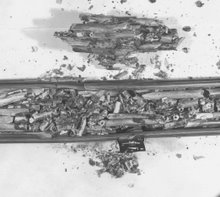Here is an abstract of a Power Point presentation that I want to present at the 2008 RELAP International Users Seminar. The first item is an e-mail from Dr. Dean Dobranich of Sandia that has brief comments related to the abstract. The next item is the abstract. I have not heard back from INL regarding my request for space on the agenda.
THIS WOULD BE A GREAT EXERCISE FOR RELAP, HOWEVER, IT IS HISTORY!
Subject:
RE: 20+ years ago
Date:
6/29/06 1:36:10 PM Mountain Daylight Time
From:
ddobran@sandia.gov
Reply To:
To:
Bobleyse@aol.com
Bob,
Nice job. My only comment concerns the last sentence. I suggest putting the emphasis on the fact that analysis is warranted to investigate the scenario you suggest. The way I read the sentence now, it seems like the emphasis is on using SCDAP/RELAP5-3D as if you are trying to drum up business for that code package. A possible alternative: "Additional UHI scenarios of concern should be investigated, perhaps using SCDAP/RELAP5-3D."
Regards,
Dean
Dean Dobranich, PhD, DMTS Thermal and Reactive Processes, 1516 SNL MS 0836, Voice: (505) 845-0446, Fax: 844-8251
From: Bobleyse@aol.com [mailto:Bobleyse@aol.com] Sent: Thursday, June 29, 2006 1:12 PMTo: Dobranich, DeanSubject: 20+ years ago
Dean:
Thank you for your searches, etc. The attached is the abstract of a PowerPoint presentation that I am preparing for an August RELAP meeting at West Yellowstone. There is maybe a 30% chance that this will be allowed.
Bob
ABSTRACT
Clarifying History via an Application of SCDAP/RELAP5-3D: Analysis of Severe Accidents for Pressurized Water Reactors with Degraded Upper Head Injection
Robert H. Leyse, CEO
Inz, Inc.
During the early 1980s the Upper Head Injection System (UHI) was added to the Emergency Core Cooling Systems (ECCS) of several pressurized water reactors having Ice Condenser Containments. UHI was added to regain operating flexibility that was lost due to the impact of the Ice Condenser design upon the 10CFR50.46 Appendix K ECCS Evaluation Model Analyses. Ice condenser design resulted in a reduced containment back pressure during a design basis loss of coolant accident decreasing the amount of steam that could be vented to the containment. The ECCS analysis results therefore required more limiting restrictions on normal plant operations in order to satisfy Appendix K requirements than were required for dry containments.
The UHI system was a high-pressure emergency injection system which supplemented the conventional ECCS. It consisted of two 1800 cubic foot accumulator tanks, one filled with subcooled borated water and the other with compressed nitrogen at 1250 psia. They were separated by a membrane that prevented pressurized nitrogen from dissolving in the borated water. This membrane ruptures once the water-filled accumulator begins delivery. As the reactor system pressure falls below 1250 psia during a loss of coolant accident (LOCA), passive check valves open and UHI borated water enters the upper head of the reactor vessel. After 1000 cubic feet of borated water has been injected, isolation valves close on a low level trip and injection ceases.
UHI systems were placed in operation during the early 1980s. The systems proved troublesome and the NRC evaluated the operating experience (reference 1), however, the NRC analysts did not identify any safety concerns. Then, on October 31, 1984, Duke Power Company shut down its McGuire Unit 1 when it determined (reference 2) that the UHI level transmitters were improperly installed and the UHI valves would have failed to isolate in the event of a LOCA.
Duke Power Company elected to remove UHI from its ice condenser plants and submitted its proposed Technical Specification Revision (reference 3) to the NRC. Also, the NRC commissioned Sandia National Laboratories to calculate the impact of failure to isolate the UHI on core temperatures during a LOCA.
On January 29, 1986, Dr. Dean Dobranich of Sandia commented in its letter report (reference 4), “These calculations suggest that failure of the UHI shutoff valves to close during a large-break LOCA may not be detrimental to the cooling of the core. The extra water injected by the upper head accumulator provides additional core cooling and the injected nitrogen flows out of the primary system without significantly interfering with refill and reflood.”
The NRC negligently (criminally) confined the Sandia calculations to the stuck-valve condition. The NRC did not include the case of a long term ruptured diaphragm prior to the LOCA, in which case the injected water would carry a substantial amount of dissolved nitrogen. More seriously, the NRC did not consider the situation of improperly functioning level transmitters, in which case there was no assurance that the water-filled accumulator had 1800 cubic feet of water, or any water. Clearly, the setup for a fast moving severe accident of Chernobyl magnitude could have been in place at any of the six ice condenser plants with UHI. Additional UHI scenarios of concern should be investigated, perhaps using SCDAP/RELAP5-3D
1. NRC Report AEOD/E404, Failures in the Upper Head Injection System, February 28, 1984.
2. NRC Report of UHI Incident, Preliminary Report of Unusual Occurrence, PNO-II-84-81, November 2, 1984.
3. Letter from H. B. Tucker (Duke Power) to H. R. Denton (USNRC), Proposed Technical Specification Revision: Deletion of Upper Head Injection System, May 9, 1985.
4. Letter Report, Dobranich (Sandia) to Watt (USNRC), LOCA Calculations for UHI Plants, January 29, 1986.
Saturday, May 31, 2008
Subscribe to:
Post Comments (Atom)

No comments:
Post a Comment